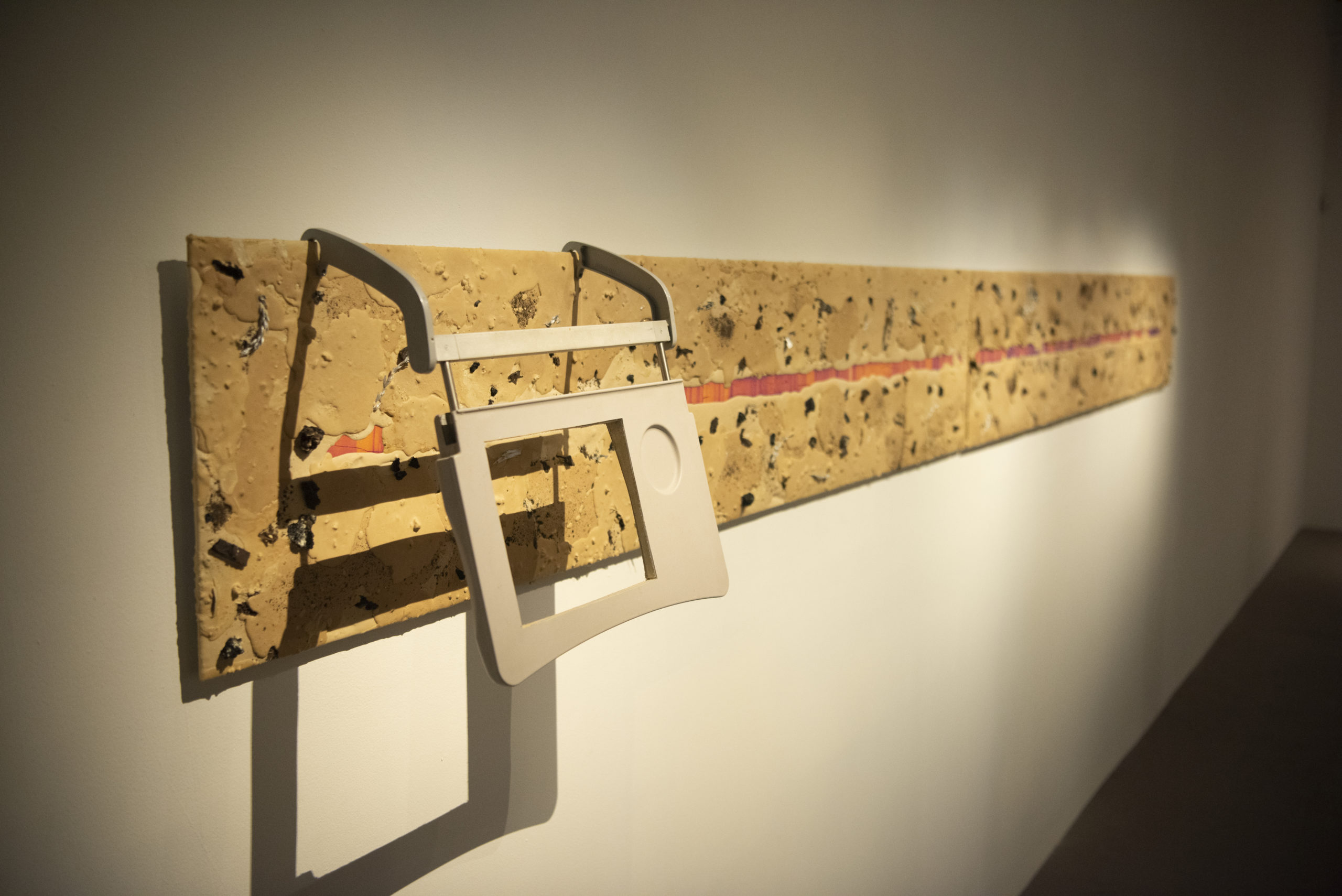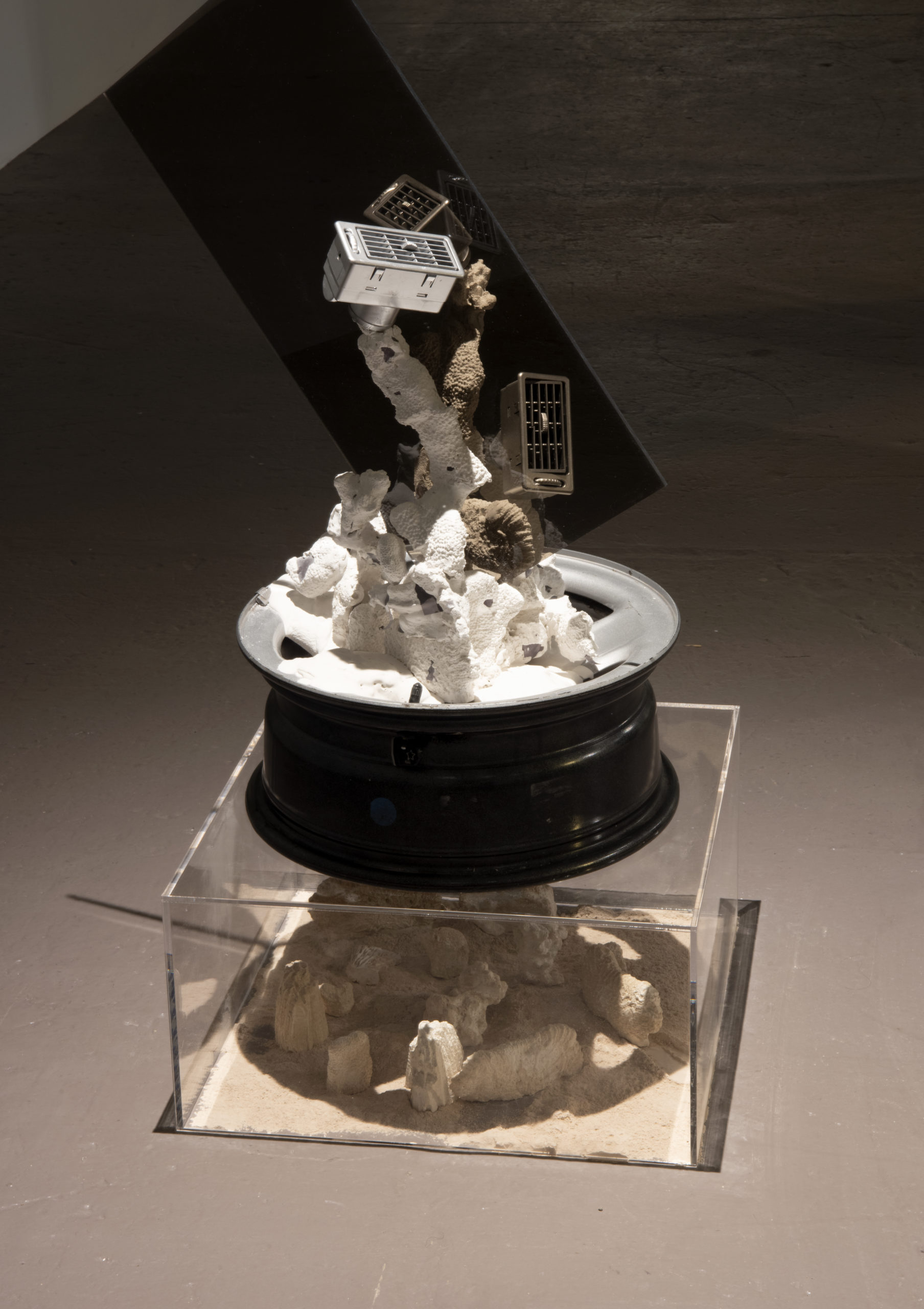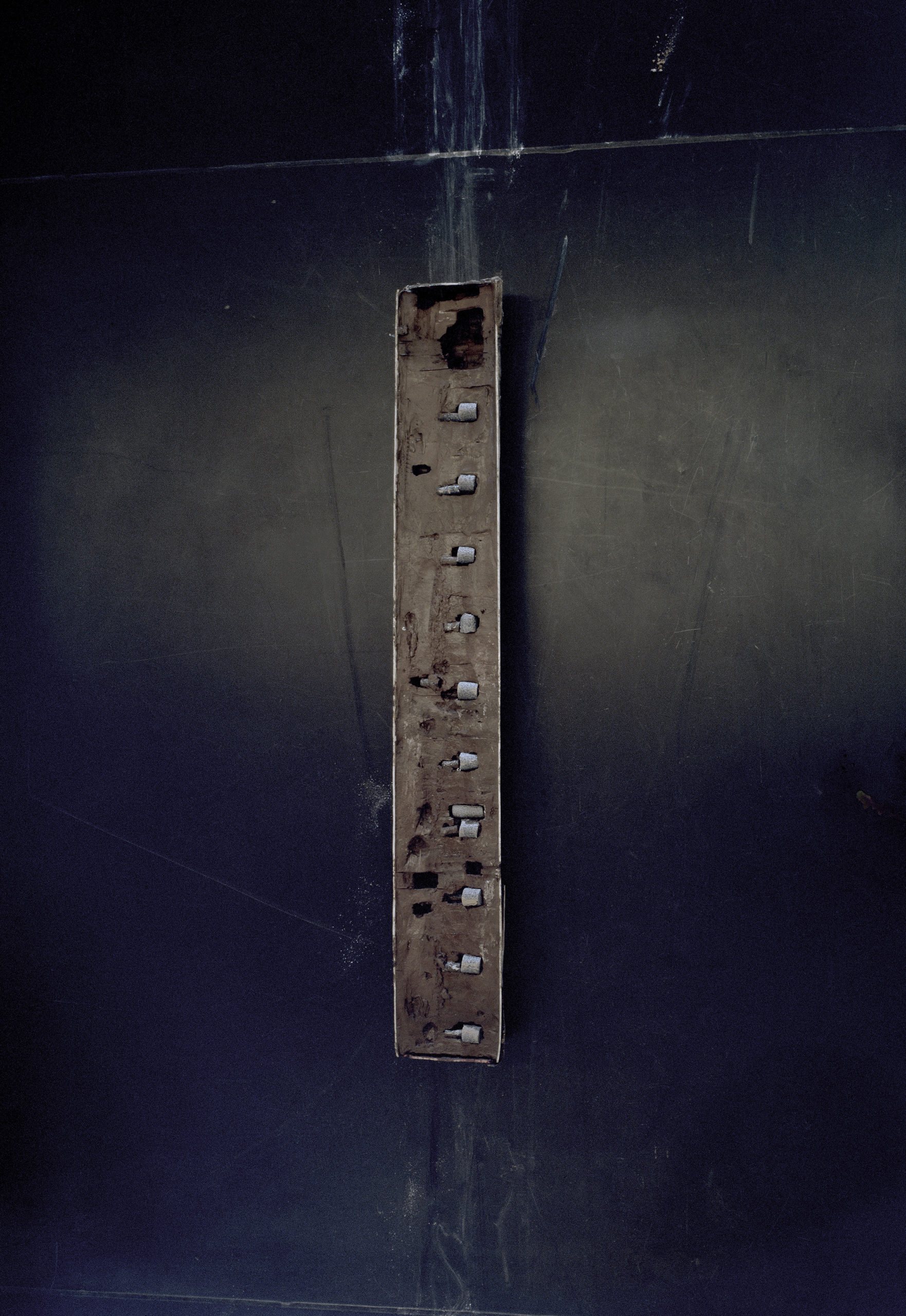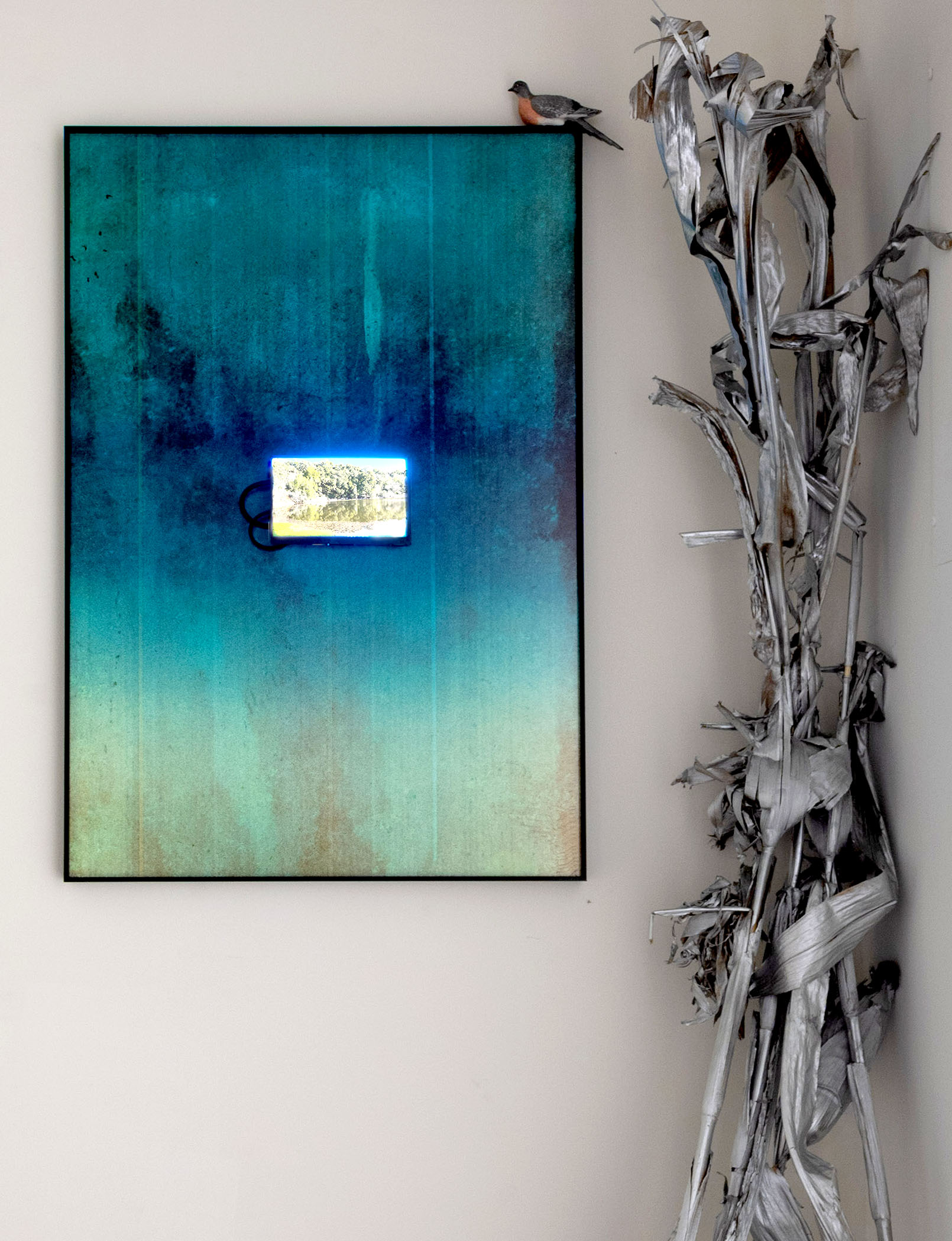Because the Sky Will Be Filled With Sulfur—Jeremy Bolen

Jeremy Bolen, Because The Sky Will Be Filled With Sulfur, installation view, 2022 [courtesy of the artist]
Share:
It is with grace that Jeremy Bolen’s exhibition Because the Sky Will Be Filled With Sulfur tackles the immense amount of information—and possible solutions—scientists are considering in response to the worsening climate crisis. The exhibition’s title refers to a proposal for engineering our climate through injecting sulfur particles into the stratosphere to reflect sunlight away and cool the planet. It’s a serious proposal—though it may sound absurd—one that abounds with unknown potential consequences. Connecting with researchers worldwide through the Anthropocene Working Group, Bolen pulls conceptually and materially from site-specific processes, gathering data from geological markers used to better understand the earth, its history, and our effects on it. The exhibition points out the gross rate of change we have inflicted upon the earth and re-imagines proposed geo-engineering solutions for climate crisis. It pushes and pulls at speculations about our past, present, and future as a species on this planet, and what will remain after the Anthropocene Epoch. Through his works, Bolen forms an aestheticized interpretation of what is happening to our world, including presentations of extensive and daunting scientific information.
Because the Sky Will Be Filled With Sulfur explores possible solutions to climate disaster, but it also reveals how the natural environment has begun to merge with byproducts of human existence. As metals, plastics, and synthetic materials that will not decompose are incorporated into the environment, and as emissions fuel global warming, a new “natural” has been established. Bolen heralds this moment in a concise and calculated manner.
Jeremy Bolen, At the Core of the Core of the Core, 2022, archival pigment print of CT scan of core sample extracted from Searsville Lake, airplane tray table, sulfur, aqua-resin, dirt extracted from the site of the world’s first nuclear reactor, asphalt, rubber mulch, reflective corn [photo: Chip Moody; courtesy of the artist and MOCA GA]
Works referencing core samples of sediment, like ones used to catalog the earth’s state over time, stretch—literally and symbolically—through the exhibition. In At the Core of the Core of the Core (2022), airplane tray tables, rubber mulch, dirt from the site of the world’s first nuclear reactor, and reflective corn are embedded in resin, along with the printed CT scan of a core sample from Searsville Lake. Together, it all becomes something like a toxic spectrum. Elsewhere, transparent pedestals enclose volcanic ash, atop which car rims of various sizes sprout coral structures and prop up tinted rectangles of glass, as car air-conditioning vents blossom from the ends. Several of these structures make up the Coral Shielding series. These works are wielded far more imaginatively, in comparison to the rest of the show, which is balanced with more meditative and clinical works, such as the Searsville Lake Sediment Core (2022), which is as dry as it gets. It is the only two-dimensional work in the exhibition, and its imagery is a cryptic photograph of a core sample—in this instance, a rectangle of earth-tone sediments—without apparent significance. Bolen posits this work as a “marker” within the show, but only a viewer with a background in geology and the proper equipment might fully understand it. Given this image, point blank, I was unable to see any bigger picture. It served as an example of how Bolen’s work abstracts the incomprehensibility of the Anthropocene situation, rendering topical and concrete information more distant from its reality.
Jeremy Bolen, Coral Shielding #1, 2022, sulfur and hydrocal cast coral, window tinting, air conditioner vents, volcanic ash 48 inches x 20 inches x 20 inches [photo: Chip Moody; courtesy of the artist and MOCA GA]
Jeremy Bolen, Searsville Lake Sediment Core, 2022, archival pigment print. 36 inches x 24 inches [courtesy of the artist and MOCA GA]
Large acrylic panes are printed with depictions of sky and clouds, like a pleasant daydream on an alien planet. The tinting on the acrylic casts a jaundiced yellow translucency in Because the Sky Will Be Filled With Sulfur #1–4. With their allusion to sulfuric skies, these works also gesture toward the proposal to use tinted shielding to block UV radiation. Such a seemingly simple proposal: the shields would function as a pair of sunglasses might, but on a scale that would tint the skies. As hypothetical solutions to the climate crisis, speculations like this feel simultaneously inspiring and frightening.
Jeremy Bolen, Because The Sky Will Be Filled With Sulfur, installation view, 2022, uv print on acrylic, sulfur cast passenger pigeon, asphalt 96 x 48 x18 inches each [courtesy of the artist]
A quiet hum pervades the space as a recording of Searsville Lake’s ambient sounds can be heard from Markers, an assemblage of video, unexposed irradiated film, a replica of the extinct passenger pigeon, and reflective corn. The reflective cornstalks represent another instance of Bolen playing with a possible future—that of reflective crops, which would bounce back into space the light and heat of the sun. The exhibition is meditative, but also a lot to take in with its translucent visage of an ominous possible future, ambient sounds of Searsville Lake, and assorted camping mats and pillows resting under a video of water and sediments that appear to drip down onto viewers.
Jeremy Bolen, Markers, 2022, archival pigment print made from expired (1963) unexposed film, monitor, video of Searsville Lake and dam (03:40), miniature passenger pigeon figurine, reflective corn 75 inches x 37 inches [photo: Jeremy Bolen; courtesy of the artist and MOCA GA]
Bolen’s exhibition brings together a lot of concerning information and realities regarding the state of the earth and our presence on it. It points out patterns and outliers, but the viewer is left to decide where to go from there. I came away wrestling with the question of what art can do for our current situation and was left with a feeling of nothingness. This lack of direction made me realize something pertinent and encompassing, if not wholly tragic. Bolen’s work points a finger at everything and nothing, everyone and no one. Finding a presence to ground the works might warm up this cold arrangement of esoteric information—an admission of vulnerability to foster some sense of empathy. Because the Sky Will Be Filled With Sulfur is noteworthy in that it doesn’t overtly promote a sense of panic and existential dread, which tends to accompany this subject matter. Perhaps, because of that, it also lacks a sense of urgency.
Noah Reyes is an artist and writer based in Atlanta. After receiving a BFA in Painting from the Maryland Institute College of Art, Noah returned to his hometown of Atlanta to entrench himself in the arts and culture of this verdant city. Writing reviews and proposals for shows, Noah hopes to blur lines between artist, writer, and curator. He is interested in experimental curation and art experiences, in trying to illuminate spaces between cultures, and in exposing what grows from those cracks between art and society.




